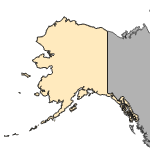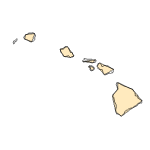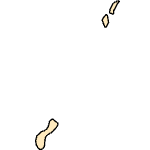Ctenopoma nigropannosum
(twospot climbing perch)
Fishes
Exotic |
|
Common name: twospot climbing perch
Taxonomy: available through
www.itis.gov
Identification: Sterba (1973) gave distinguishing characteristics. See Axelrod et al. (1985) and FishBase for color photographs of live fish. Genus includes approximately 16 species (Norris et al. 1988).
Size: 17 cm.
Native Range: Tropical Africa. Native to Niger River delta and Congo River basin (Sterba 1973, see Norris et al. 1988)



|

Alaska |

Hawaii |

Puerto Rico &
Virgin Islands |

Guam Saipan |
Hydrologic Unit Codes (HUCs) Explained
Interactive maps: Point Distribution Maps
Nonindigenous Occurrences:
Table 1. States with nonindigenous occurrences, the earliest and latest observations in each state, and the tally and names of HUCs with observations†. Names and dates are hyperlinked to their relevant specimen records. The list of references for all nonindigenous occurrences of Ctenopoma nigropannosum are found here.
Table last updated 11/28/2024
† Populations may not be currently present.
Means of Introduction: Probable escape from local aquarium fish farm (Courtenay et al. 1974).
Status: Extirpated. In the past, it was locally established in Florida, but no specimens have been collected since the 1970s (Courtenay and Hensley 1979). Disappearance was possibly the result of cold winter temperatures (Courtenay and Hensley 1979; Courtenay et al. 1984; Courtenay and Stauffer 1990). Shafland et al. (2008) list it as a formerly reproducing species.
Impact of Introduction: The impacts of this species are currently unknown, as no studies have been done to determine how it has affected ecosystems in the invaded range. The absence of data does not equate to lack of effects. It does, however, mean that research is required to evaluate effects before conclusions can be made.
References: (click for full references)
Axelrod, H. R., W. E. Burgess, N. Pronek, and J. G. Walls. 1985. Dr. Axelrod's atlas of freshwater aquarium fishes. Tropical Fish Hobbyist Publications, Inc., Neptune City, NJ.
Courtenay, W. R., Jr., and D. A. Hensley. 1979. Survey of introduced non-native fishes. Phase I Report. Introduced exotic fishes in North America: status 1979. Report Submitted to National Fishery Research Laboratory, U.S. Fish and Wildlife Service, Gainesville, FL.
Courtenay, W. R., Jr., and J. R. Stauffer, Jr. 1990. The introduced fish problem and the aquarium fish industry. Journal of the World Aquaculture Society 21(3):145-159.
Courtenay, W. R., Jr., and J. R. Stauffer, Jr., editors. 1984. Distribution, biology and management of exotic fishes. Johns Hopkins University Press, Baltimore, MD.
Shafland, P.L., K.B. Gestring, and M.S. Sanford. 2008. Categorizing introduced fishes collected from public waters. Southeastern Naturalist 7(4):627-636.
Sterba, G. 1973. Freshwater fishes of the world. English translation and revision from German. Two volumes. Tropical Fish Hobbyist Publications, Inc., Neptune City, NJ.
Other Resources:
FishBase Summary
Author:
Leo Nico, and Pam Fuller
Revision Date: 6/7/2012
Peer Review Date: 6/7/2012
Citation Information:
Leo Nico, and Pam Fuller, 2024, Ctenopoma nigropannosum Reichenow, 1875: U.S. Geological Survey, Nonindigenous Aquatic Species Database, Gainesville, FL, https://nas.er.usgs.gov/Queries/FactSheet.aspx?SpeciesID=307, Revision Date: 6/7/2012, Peer Review Date: 6/7/2012, Access Date: 11/28/2024
This information is preliminary or provisional and is subject to revision. It is being provided to meet the need for timely best science. The information has not received final approval by the U.S. Geological Survey (USGS) and is provided on the condition that neither the USGS nor the U.S. Government shall be held liable for any damages resulting from the authorized or unauthorized use of the information.